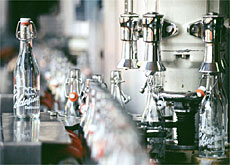
Ticino lemonade loses its fizz

Producers of a speciality fizzy drink in Switzerland’s southern canton of Ticino are struggling to survive as production costs rise.
Gazosa Ticinese has been enjoyed for more than six decades, but its popularity is mainly confined to the Italian-speaking canton.
More than three million bottles are produced every year but only a small fraction is “exported” to German-speaking Switzerland.
This is partly due to the high production costs of the traditional glass bottle with a flip top.
Franco Carugati of the cantonal association of drink producers, says it is important to return the empty bottles, which cost SFr2 ($1.4) each to produce.
“This is part of the reason why we do not export as many bottles to German-speaking Switzerland,” he told swissinfo.
“If the bottles are not returned the producers will make a loss,” Carugati explained.
However, Gazosa Ticinese is still served in some bars and pubs in German-speaking cities like Basel, Zurich or Bern. Its fancy bottle makes the soft drink from Ticino popular with pub owners who want to offer something special.
The first bottle used for the drink, which has been produced since 1940, was shaped like a glass ball that was forced open by the pressure of the carbon dioxide gas.
Poor man’s champagne
When opened the bottle popped like a champagne cork, which is why the popular lemonade was dubbed the “champagne of the poor”.
The soft drink is available in lemon and a number of other flavours including tangerine, raspberry and bitter orange.
Gazosa Ticinese is exclusively produced by family businesses in the canton,
many of which are experiencing financial problems.
“It is difficult for them to survive in an industry which is dominated by mineral water,” Carugati told swissinfo.
Carugati owns Coldesina, Ticino’s oldest lemonade factory that was founded in 1885.
High investment
The fact that the infrastructure of many factories is outdated also puts a financial strain on many businesses.
In future producers will have to fix a paper seal to the flip tops, and a machine that attaches this seal as well as prints the production and expiry dates on the bottles costs SFr140,000.
“Such an investment will not pay off considering how little lemonade is being produced,” Carugati told swissinfo and pleaded for more co-operation between the family businesses.
Giorgio Romerio from Locarno stopped producing Gazosa ten years ago, and now sends the traditional glass bottles to Ambra in Personico, where they are filled with still water.
“It is very likely that other small businesses will have to follow Romerio’s example, and it could even be possible that there will be only one Gazosa factory in Ticino in the near future,” laments Carugati.
swissinfo, Gerhard Lob in Bellinzona (translation: Billi Bierling)
More than three million bottles of Gazosa are produced in Ticino each year.
The production of one glass bottle, the trademark of the drink, costs SFr2.
The first bottle was produced in 1940.

In compliance with the JTI standards
More: SWI swissinfo.ch certified by the Journalism Trust Initiative





























You can find an overview of ongoing debates with our journalists here . Please join us!
If you want to start a conversation about a topic raised in this article or want to report factual errors, email us at english@swissinfo.ch.